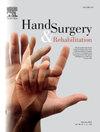Walant technique in wrist fractures
IF 0.9
4区 医学
Q4 ORTHOPEDICS
引用次数: 0
Abstract
Introduction
Fractures of the distal radius are one of the most common types of injuries encountered in hand surgery. Plate osteosynthesis is recommended for unstable fractures.
Distal radius fractures are treated using open reduction and internal fixation and using general anesthesia (GA) or regional blocks. Wide-awake local anesthesia with no tourniquet (WALANT), allows this operation to be conducted in non-sedated patients without the use of tourniquets.
Material and methods
We use a combination of 1% lidocaine, 1:100,000 epinephrine, and 10:1 8.4% sodium bicarbonate. However, we use only 40 mL of the prepared solution because we strictly adhere to the safe limit of 7 mg/kg for lidocaine with epinephrine. First, a total of 10 mL of subcutaneous local anesthesia is infiltrated using a 27-gauge needle along the modified Henry skin incision. We inject the solution using a 23-gauge needle at the radial border of the radius where it is easily palpable. A total of 30 mL of local anesthesia is used starting proximally with 10 mL in each injection site. It is ideal to allow the local anesthesia a duration of at least 30 minutes to take effect. It takes an average of 25 minutes for maximal cutaneous vasoconstriction to occur with 1:100,000 epinephrine.
Discussion
This technique was first introduced and popularized in the 1980's by Dr. D. Lalonde, a plastic surgeon from Canada working in hand surgery for the past 10 years. This technique relies on the injection of buffered diluted lidocaine with epinephrine at the surgical site. The tourniquet at the base of the limb, which is a source of discomfort, becomes unnecessary as the epinephrine acts as a chemical tourniquet. This technique can also help prevent the potential complications associated with regional or general anesthesia and can be used in patients who are not eligible for general anesthesia [1], [2], [3], [4], [5], [6], [7], [8], [9].
Conclusion
The WALANT technique is an easily applied, safe, and efficient anesthetic technique for open reduction and internal fixation of distal radius fractures. It does not require tourniquet so it keeps the patient free from tourniquet pain and complications. It is economical because it doesn’t require for any more expensive preoperative investigations. It does not require sedation, which allows the patients to communicate with the doctors during the procedure and perform active movement of the operated limb to examine if there is an impingement of implants.
腕部骨折的Walant技术
桡骨远端骨折是手部手术中最常见的损伤类型之一。不稳定骨折推荐钢板固定。桡骨远端骨折采用切开复位内固定和全身麻醉(GA)或局部阻滞治疗。无止血带的全清醒局麻(WALANT)允许在未镇静的患者中不使用止血带进行该手术。材料和方法我们使用1%利多卡因,1:10万肾上腺素和10:1 8.4%碳酸氢钠的组合。然而,我们只使用40毫升的配制溶液,因为我们严格遵守利多卡因与肾上腺素的安全限量7毫克/公斤。首先,使用27号针头沿改良的Henry皮肤切口浸润10ml皮下局部麻醉。我们用一根23号针头在桡骨边缘容易触及的地方注射溶液。共使用30ml局部麻醉,从近端开始,每个注射部位10ml。理想情况下,局部麻醉至少要持续30分钟才能生效。使用1:10万肾上腺素时,皮肤血管收缩达到最大平均需要25分钟。这项技术最早是在20世纪80年代由Dr. D. Lalonde博士提出并推广的,他是一位来自加拿大的整形外科医生,在过去的10年里一直从事手部手术。这种技术依赖于在手术部位注射含有肾上腺素的缓冲稀释利多卡因。肢体底部的止血带是不舒服的来源,由于肾上腺素起到化学止血带的作用,它变得不必要了。该技术还有助于预防与区域或全身麻醉相关的潜在并发症,可用于不适合全身麻醉[1],[2],[3],[4],[5],[6],[7],[8],[9]的患者。结论WALANT技术用于桡骨远端骨折切开复位内固定是一种简便、安全、有效的麻醉技术。它不需要止血带,所以它使病人免于止血带疼痛和并发症。它是经济的,因为它不需要任何更昂贵的术前检查。它不需要镇静,这使得患者可以在手术过程中与医生交流,并进行手术肢体的主动运动来检查是否有植入物的撞击。
本文章由计算机程序翻译,如有差异,请以英文原文为准。
求助全文
约1分钟内获得全文
求助全文
来源期刊

Hand Surgery & Rehabilitation
Medicine-Surgery
CiteScore
1.70
自引率
27.30%
发文量
0
审稿时长
49 days
期刊介绍:
As the official publication of the French, Belgian and Swiss Societies for Surgery of the Hand, as well as of the French Society of Rehabilitation of the Hand & Upper Limb, ''Hand Surgery and Rehabilitation'' - formerly named "Chirurgie de la Main" - publishes original articles, literature reviews, technical notes, and clinical cases. It is indexed in the main international databases (including Medline). Initially a platform for French-speaking hand surgeons, the journal will now publish its articles in English to disseminate its author''s scientific findings more widely. The journal also includes a biannual supplement in French, the monograph of the French Society for Surgery of the Hand, where comprehensive reviews in the fields of hand, peripheral nerve and upper limb surgery are presented.
Organe officiel de la Société française de chirurgie de la main, de la Société française de Rééducation de la main (SFRM-GEMMSOR), de la Société suisse de chirurgie de la main et du Belgian Hand Group, indexée dans les grandes bases de données internationales (Medline, Embase, Pascal, Scopus), Hand Surgery and Rehabilitation - anciennement titrée Chirurgie de la main - publie des articles originaux, des revues de la littérature, des notes techniques, des cas clinique. Initialement plateforme d''expression francophone de la spécialité, la revue s''oriente désormais vers l''anglais pour devenir une référence scientifique et de formation de la spécialité en France et en Europe. Avec 6 publications en anglais par an, la revue comprend également un supplément biannuel, la monographie du GEM, où sont présentées en français, des mises au point complètes dans les domaines de la chirurgie de la main, des nerfs périphériques et du membre supérieur.
 求助内容:
求助内容: 应助结果提醒方式:
应助结果提醒方式:


